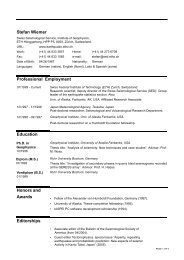zmap a tool for analyses of seismicity patterns typical applications ...
zmap a tool for analyses of seismicity patterns typical applications ...
zmap a tool for analyses of seismicity patterns typical applications ...
You also want an ePaper? Increase the reach of your titles
YUMPU automatically turns print PDFs into web optimized ePapers that Google loves.
Using Gephart’s code<br />
An alternative code to compute stress tensor was given by Gephart [Gephart, 1990a;<br />
Gephart, 1990b; Gephart and Forsyth, 1984]. His code per<strong>for</strong>ms a complete grid search<br />
<strong>of</strong> the parameter space. The ZMAP6 version <strong>of</strong> the code is essentially unchanged from<br />
the ZMAP5 version, with the exception that now a precompiled PC version is also<br />
available. The data input <strong>for</strong>mat is identical to the one <strong>for</strong> Michael’s inversion. Note that<br />
significant differences between the two methods have been observed in special cases.<br />
For UNIX or LINUX version, you need to precompiled a few files, that are located in the<br />
external/src_unix directory. Check the INFO file in this directory <strong>for</strong> in<strong>for</strong>mation on<br />
compiling.<br />
To initiate a stress tensor inversion, select the "Invert <strong>for</strong> stress tensor" option from the<br />
Tools pull down menu <strong>of</strong> the Cumulative Number window. The dataset currently selected<br />
in this window will be used <strong>for</strong> the inversion. The actual inversion is per<strong>for</strong>med using a<br />
Fortran code based on Gephart and Forsyth [1984] algorithm, and modified by Zhong<br />
Lu.<br />
The actual program is described and discussed by Gephart and Forsyth [1984], Gephart<br />
(1990), [Lu and Wyss, 1996; Lu et al., 1997] and [Gillard et al., 1995]. Two main<br />
assumptions need are made: 1) the stress tensor is uni<strong>for</strong>m in the crustal volume<br />
investigated; 2) on each fault plane slip occurs in the direction <strong>of</strong> the resolved shear<br />
stress. In order to invert the focal mechanism data successfully <strong>for</strong> the direction <strong>of</strong><br />
principal stresses, one must have a crustal volume with faults representing zones <strong>of</strong><br />
weakness with different orientations in a homogeneous stress field. If only one type <strong>of</strong><br />
focal mechanism is observed, then the direction <strong>of</strong> the principal stresses would be poorly<br />
constraint (modified from Gillard and Wyss, 1995)<br />
47



